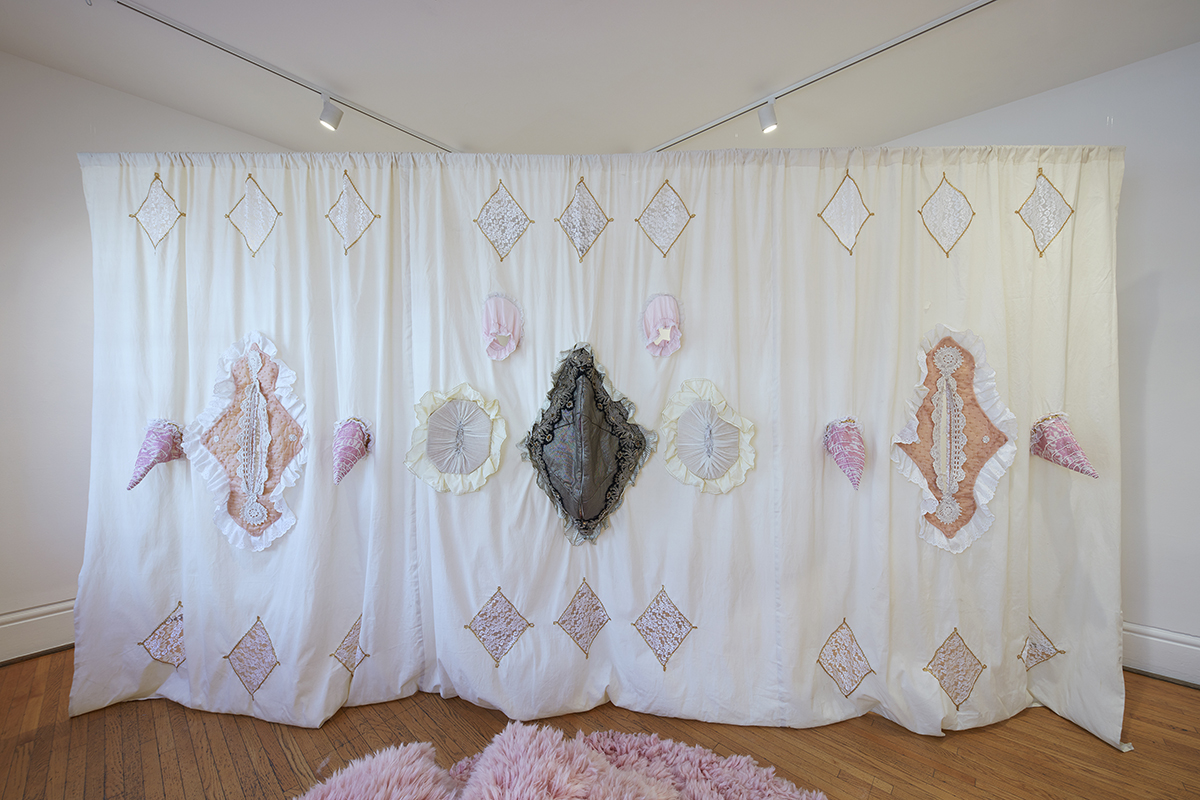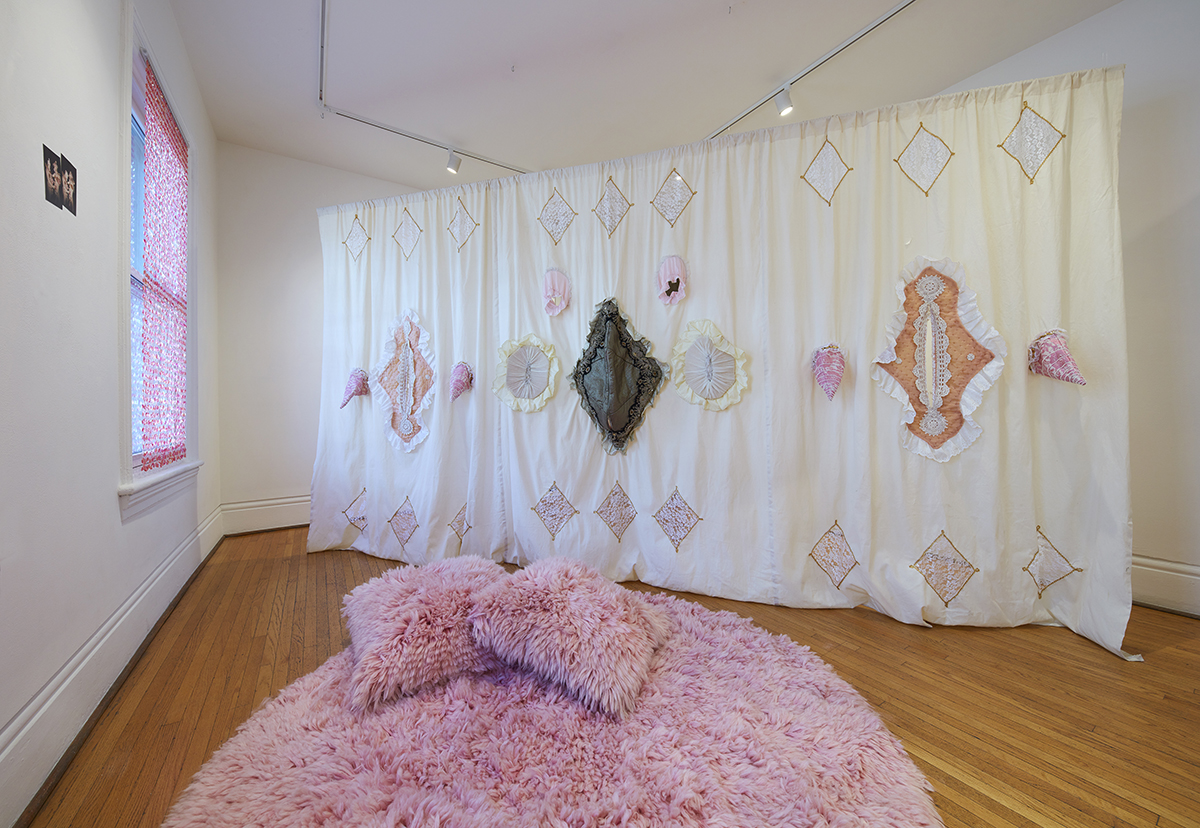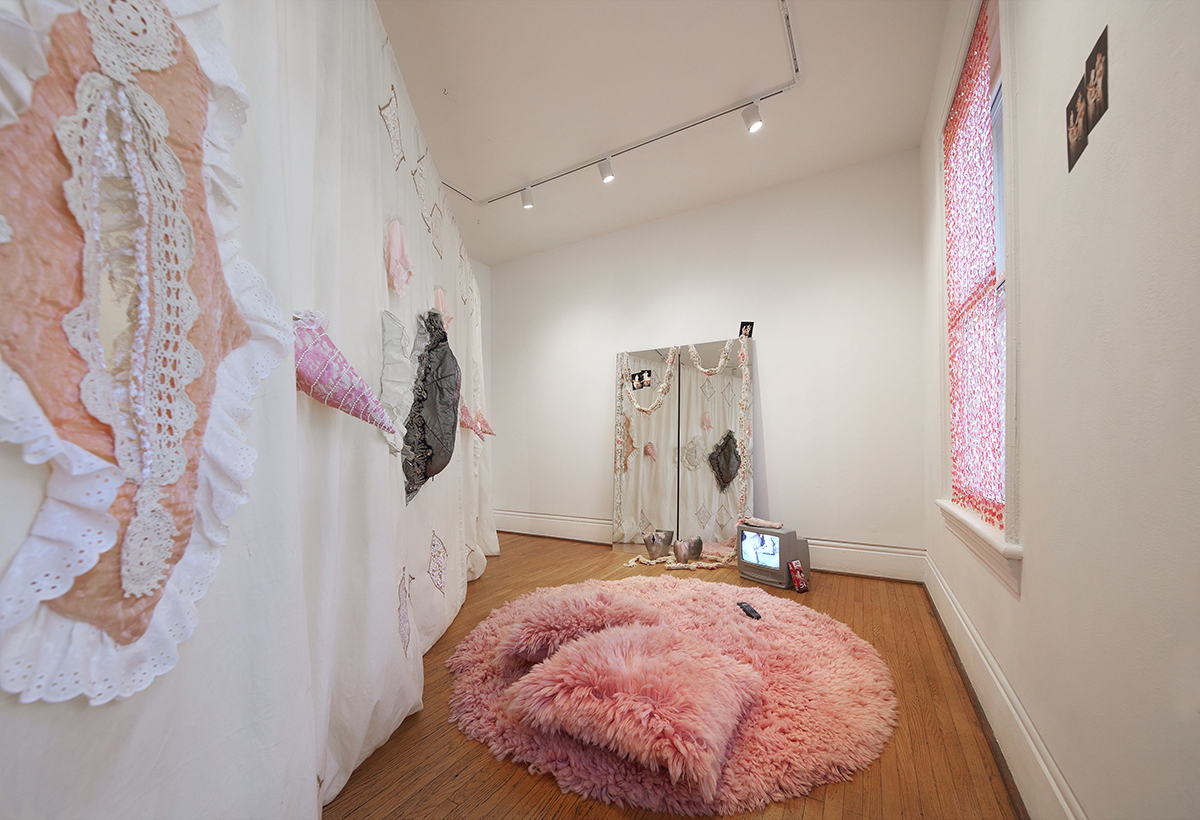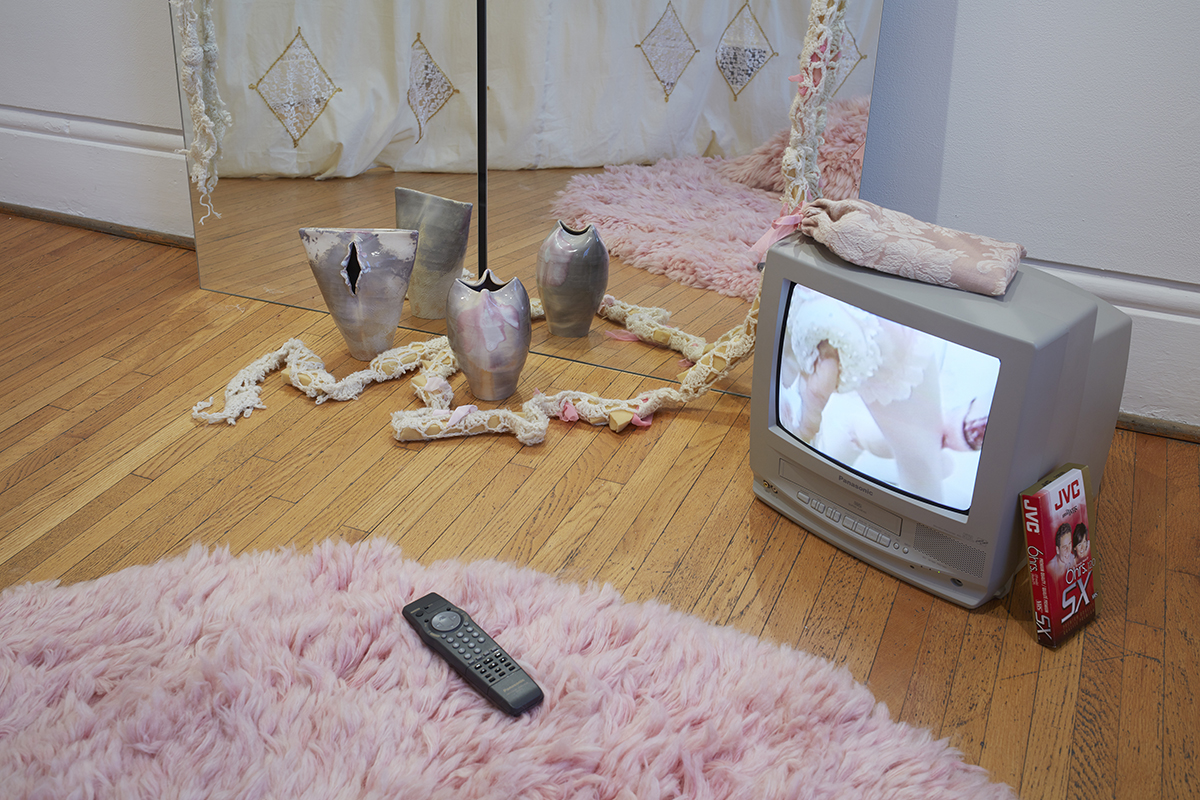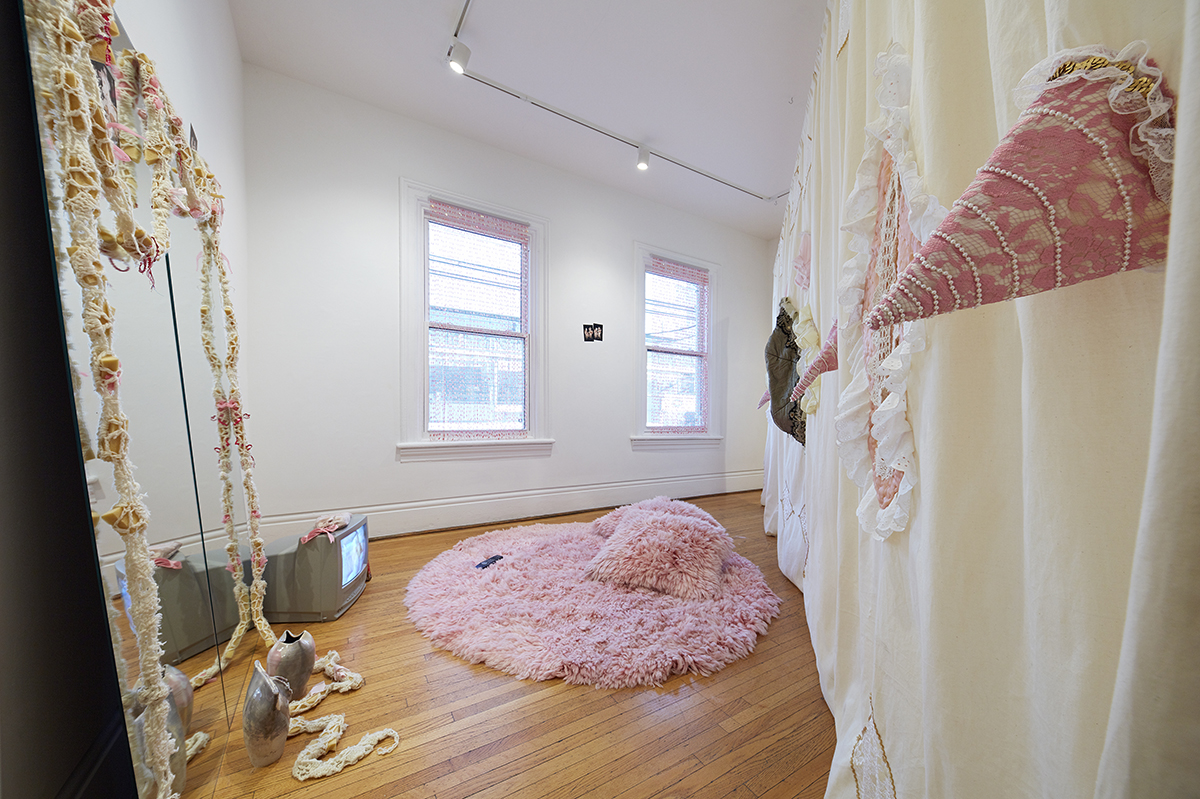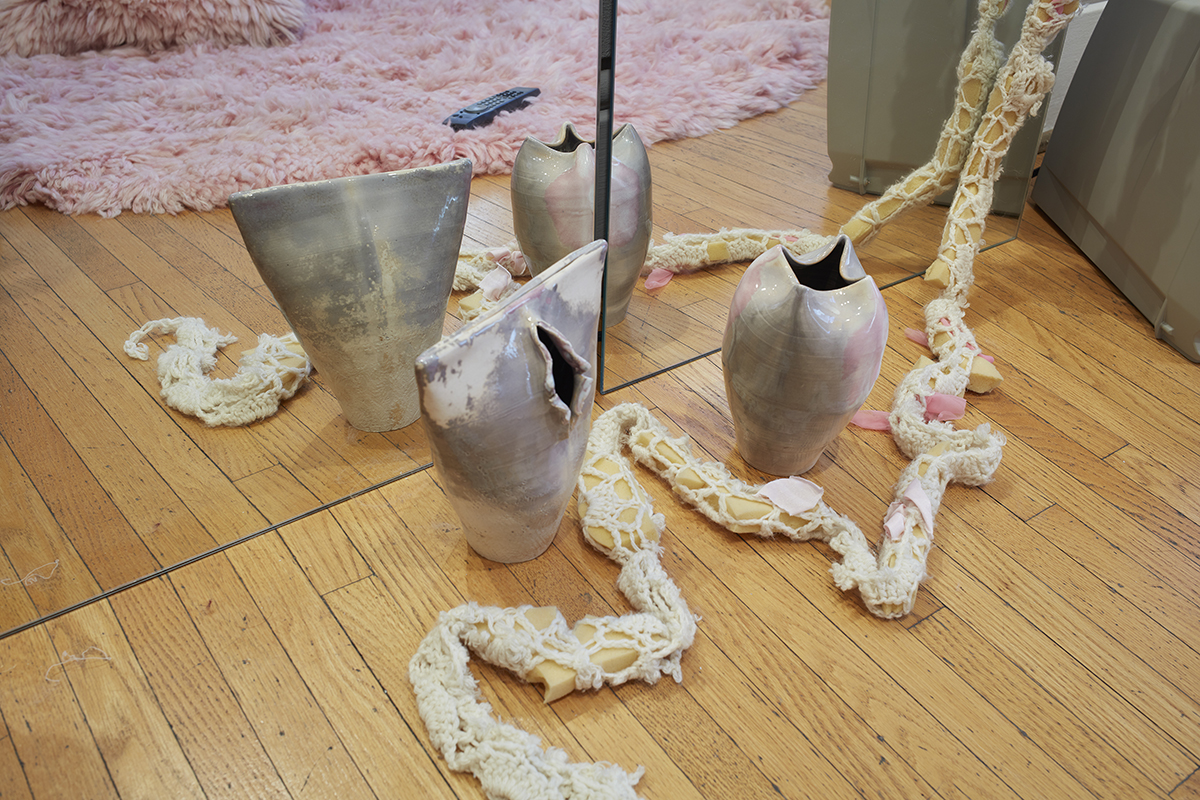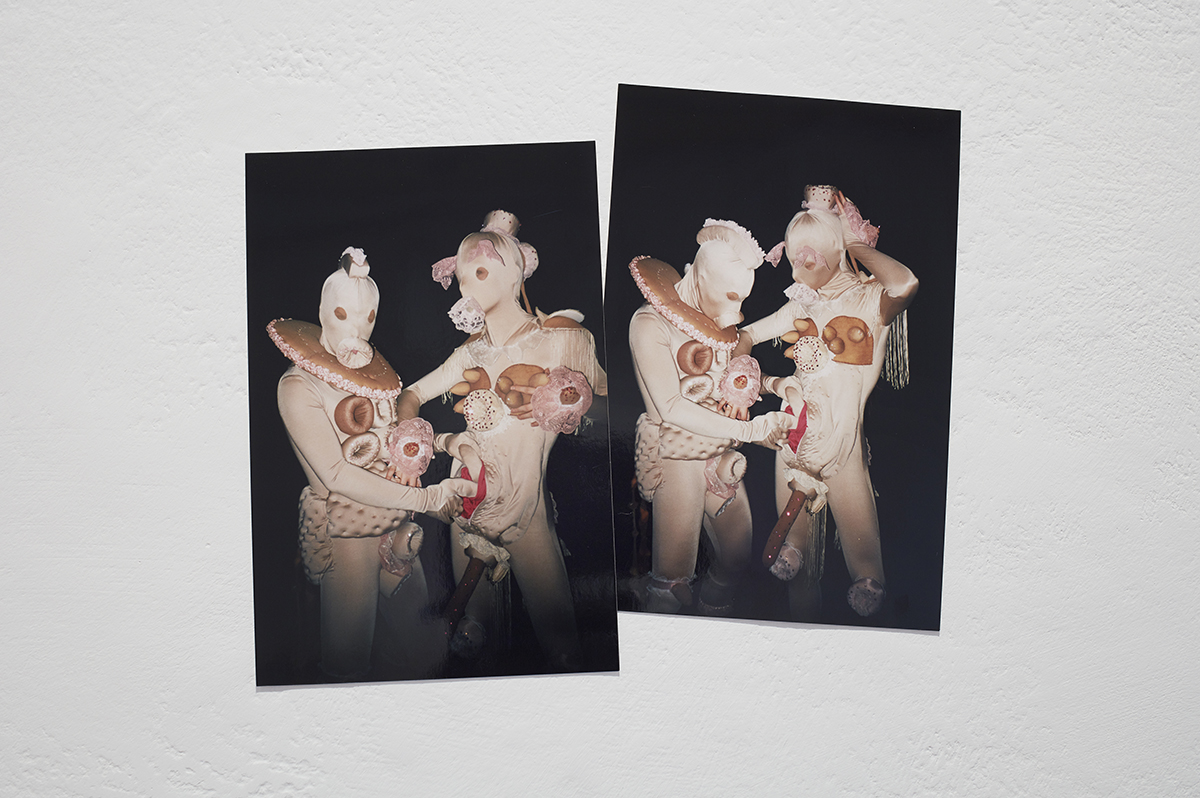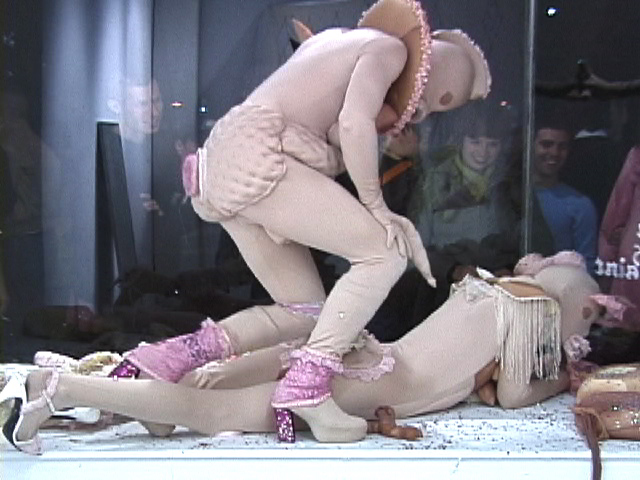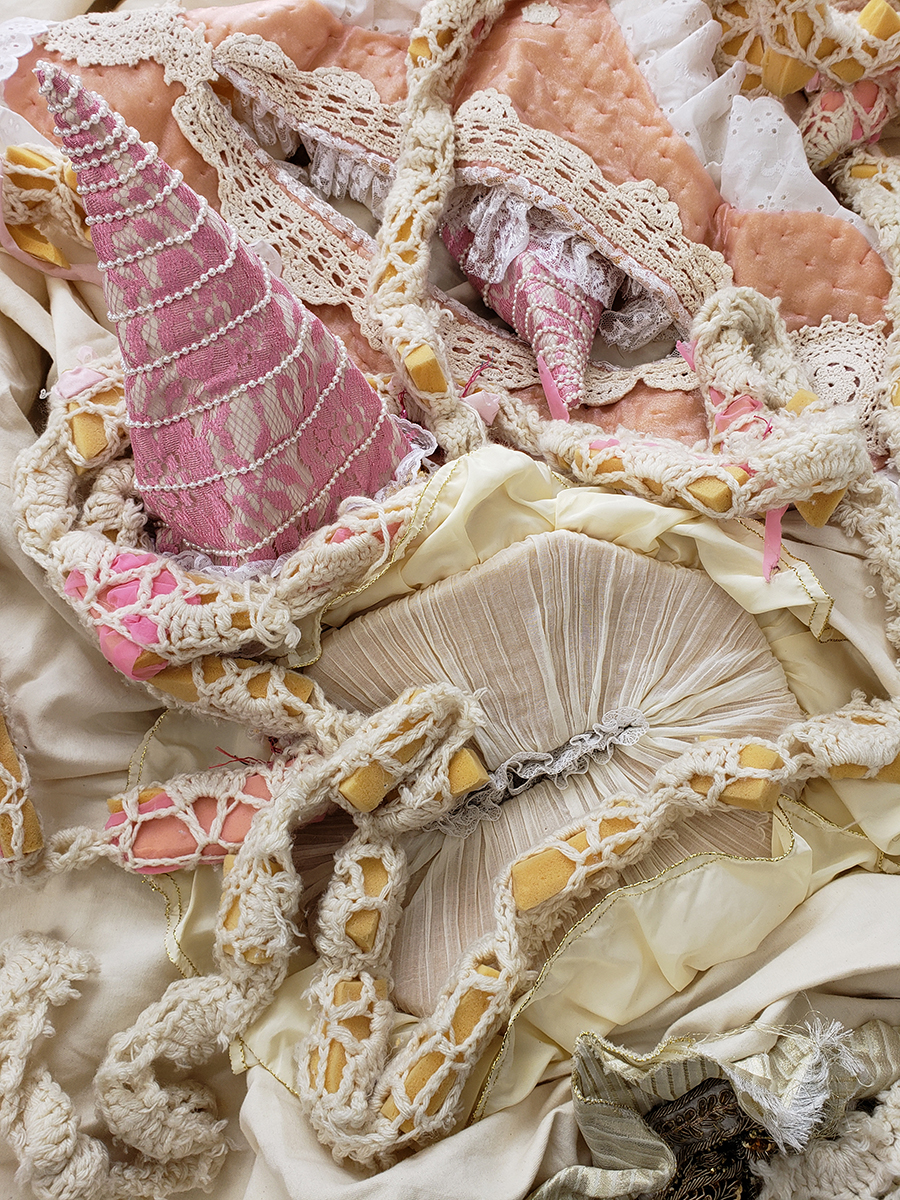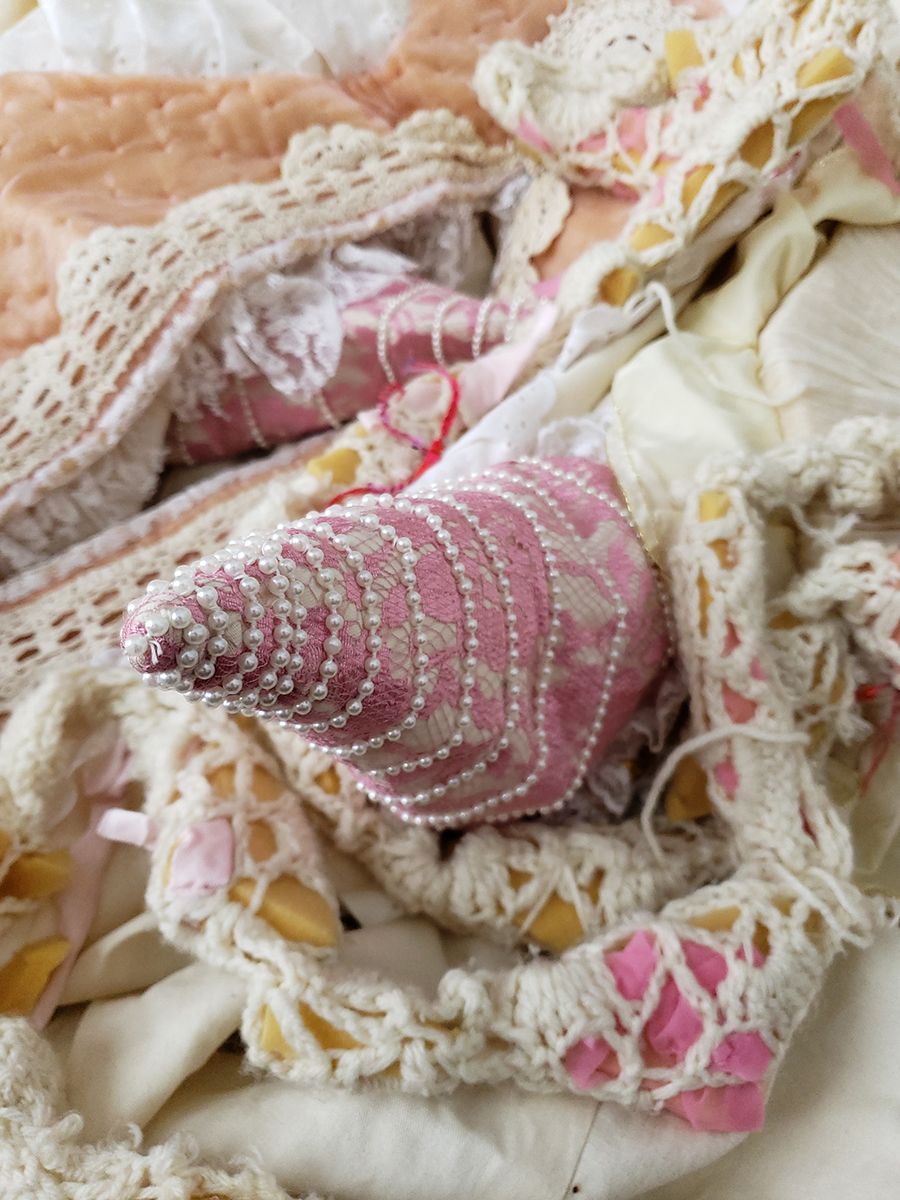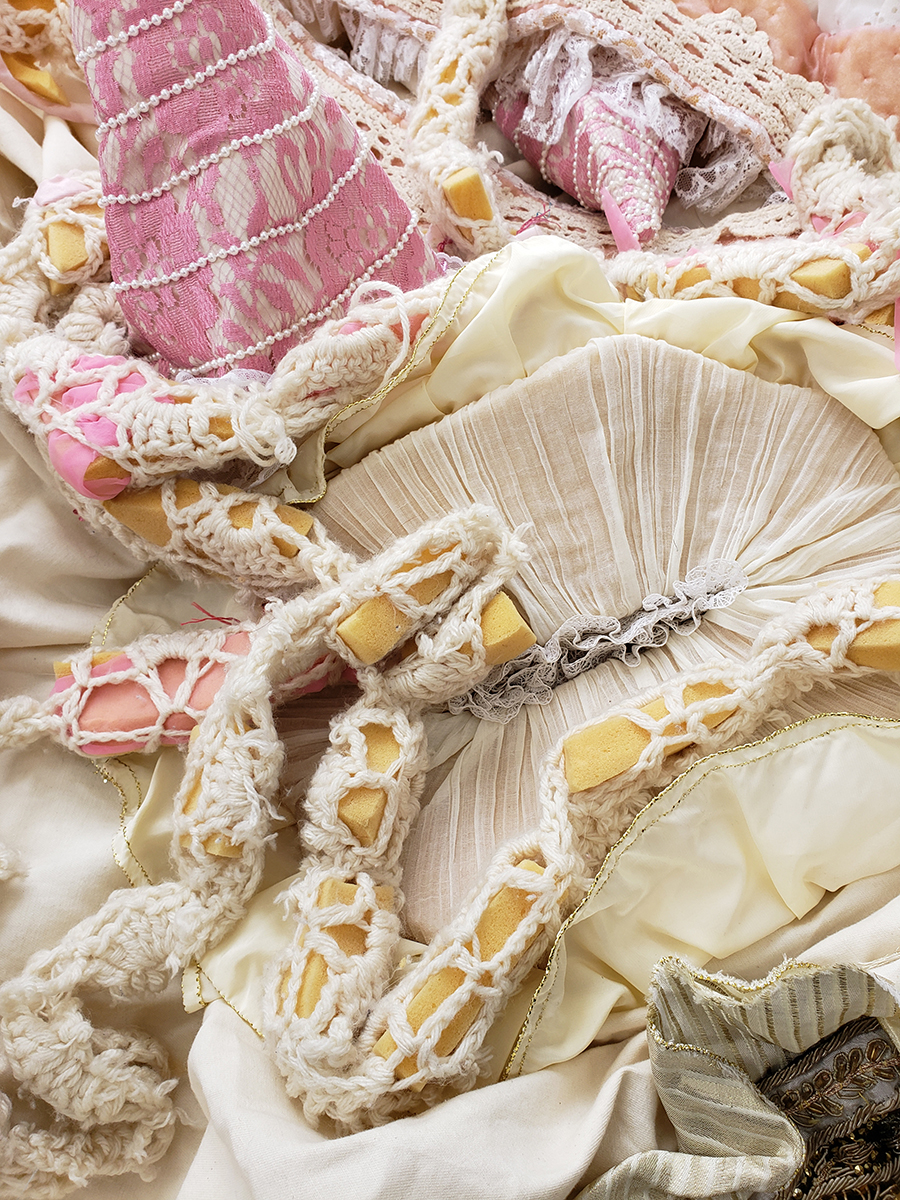Virginia's Room
Jeremy Laing, Estate of Will Munro
installation
June 7 - July 6, 2019
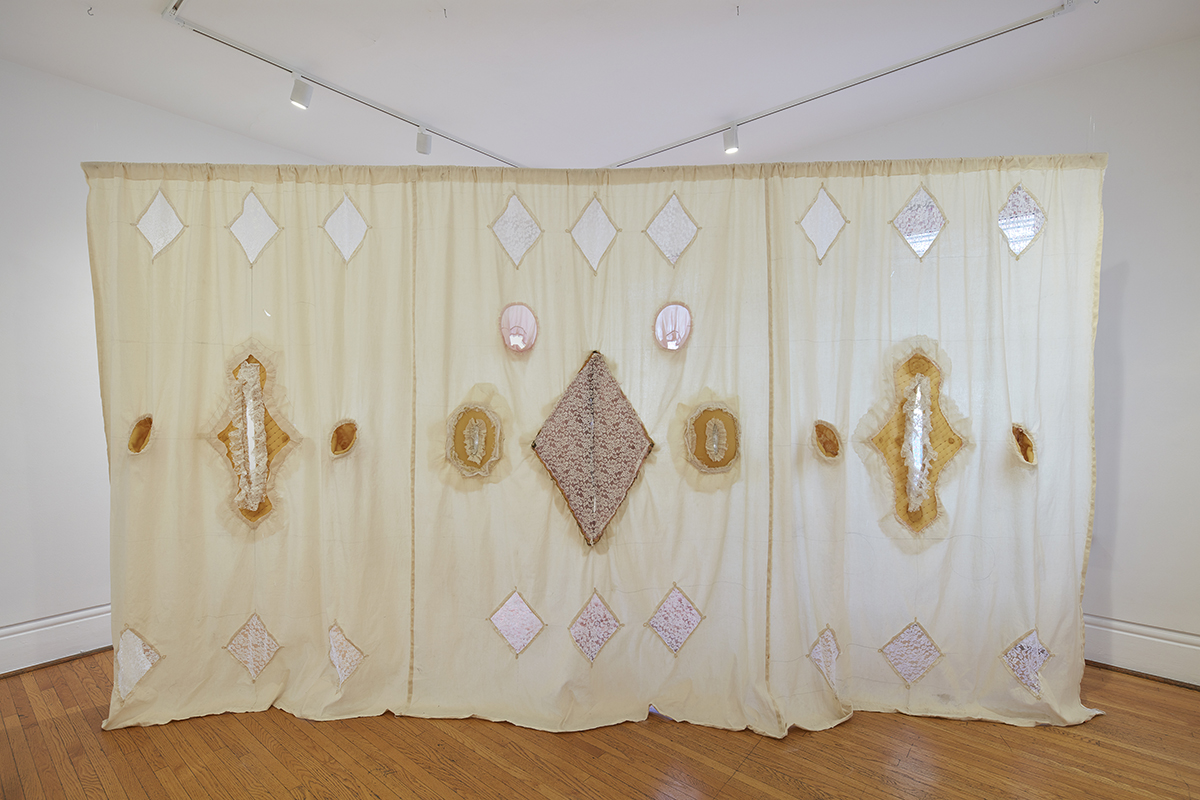
Will Munro and I spent the summer of 2003 crafting costumes and a set for an interactive performance — The Wall of Virginia Puff-Paint — that we presented at Zsa Zsa Gallery, on Queen Street West, in September of that year.
So much of the project was informed by queer erasure, and sought to forge connections to departed forebears, which now also include Will. It has been personally meaningful to unpack Virginia's effects so many years later, and, as collaborator originally, now custodian and solo artist, to refigure the installation in the context of his absence. It feels fitting that a project centred around reveling in and revealing queer legacies should now come back around to remind us of Will's own.
Please join me in Virginia's Room.
If you would like to meet Virginia in the collaborative, performative and interactive spirit in which she eternally resides, and help fulfil in some small way art’s promise that it does good, feel free to stuff her bottomless alms vessels with as much as she can take for the Will Munro Fund for Queer and Trans People Living with Cancer.
— Jeremy Laing
exhibition text by Luis Jacob
The lady was a tramp. Not that Virginia was much of a lady, mind you. Anyway, she started life on Queen St West at a grittier time before Jeff Stober opened his kingdom at the Drake, and before Christina Zeidler opened her queendom at the Gladstone. A time before Ossington was Williamsburg North and before selfies were a thing, if you know what I mean.
Back in 2003, Virginia went looking for a suitable abode to flaunt her questionable peccadilloes and, as luck would have it, she met Andrew Harwood. The goddess works in mysterious ways! Along with Keith Cole and Richard Vaughan, Andrew was one of Three Evil Queens you’d see casting their spells at Vazaleen, Will Munro’s legendary queer party. Naturally, I mean “Evil” in the best possible sense. Andrew once fucked a watermelon onstage at Lee’s Palace, if that’s any indication. Anyway, Virginia met Andrew, and it turned out he was running a gallery called Zsa Zsa across the street from CAMH. Virginia was duly impressed.
Dominant artiste that she is, Virginia immediately put her minions Jeremy and Will to work, and that summer the boys were elbow-deep in glitter. You know the adage that glitter is the herpes of the craft-world? The way you’ll find glitter on your couch, glitter in your bathtub, glitter in your butt-crack for weeks after a heavy session? Well, the boys had a bad case of it.
Everything had to be perfect. Each sequin in place, each orifice gloriously pearled, each protrusion marvellously sheathed in lace. Virginia Puff-Paint looked approvingly at her creation. She was building an empire – a pleasure-dome of earthly delights. First was the Wall of Virginia Puff-Paint at Zsa Zsa in September 2003. Then came the Pavilion of Virginia Puff-Paint at AGYU in 2004. The flesh is weak, but the spirit lives on.
As you enter Virginia’s Room, feel the way her sissy-ness overwhelms your masc4masc sensibilities (if you have any). Savour the way she consensually and delicately dilates your psyche, as you make yourself comfortable in her boudoir – you, who’ve found this sacred space. Drink it in. Avail yourself of her energies.
They say an army of lovers will never be defeated, and this much of what I tell you is true. Drink it all in. You’re gonna need your strength and your magic powers for the battles unfolding around us.
Luis Jacob, June 1, 2019
(from wikipedia)
Born in Australia, Will Munro grew up mostly in Mississauga, Ontario, Canada, and moved to nearby Toronto to study at the Ontario College of Art, graduating in 2000. Influenced by such artists as General Idea and the queercore movement, he received critical attention for his work with men’s underwear, a medium he used eventually to create collages of colourful performers he admired such as Klaus Nomi and Leigh Bowery. He created silkscreen posters to advertise Vazaleen—his monthly nightclub party that was unusual for being a queer event where punk and other rock music was prominently played, and for being one of the first to exist beyond the confines of the gay ghetto. The party was known for attracting a diverse crowd, and at its peak brought in such performers as Nina Hagen; international “best-of” nightclub lists took notice.
Munro died of brain cancer in May 2010. Posthumous exhibits of his art work included a 2010 show at the Art Gallery of Ontario, and in 2011 he was the first male artist to be featured in the feminist Montreal art gallery La Centrale.
Will Munro was born in Sydney, Australia in 1975. Later that year his family moved to Canada, just outside of Montreal, and then lived in Mississauga, Ontario from 1980 onwards.
Despite his involvement in nightclub events, Munro did not consume alcohol or recreational drugs. He was a vegan from a young age. For many years, he volunteered as a peer counsellor at the Toronto Lesbian Gay Bi Trans Youth Line, where an annual award was established in his honour after his death.
Munro was diagnosed with brain cancer and underwent surgery to remove a tumour in 2008. A second surgery was performed in October 2009. He entered into palliative care in April 2010, and died on May 21, 2010.
Munro moved from Mississauga to Toronto after high school, to attend the Ontario College of Art (OCA). From early on in his career, his signature medium was pastiche work with men’s underwear.The origins of this work date back to his Intro to Sculpture class at OCA, where his professor asked the students to “bring a special object to class that isn’t really functional, but is special to you.” Munro had long had an affinity for special underwear, ever since his mother had refused to buy him Underoos superhero underwear when he was a child; regarding white briefs, he said, “They were clinical and sterile. They weren’t very sexy. It just felt very repressed. I wanted Underoos so bad.” For the sculpture class, Munro decided to bring in a pair of underwear that he had stolen from a high school friend on whom he had a crush. He put the grey underwear on display in a Plexiglass cage, complete with air holes. In his subsequent work he decided to use white briefs as a medium “because they were so accessible.” The summer after his sculpture class, to keep himself busy on a road trip, he made a quilt out of white underwear. In 1997, his first show involving underwear was held in a gallery supported by his college. The show received publicity after conservative columnist Michael Coren, in the Toronto Sun and on the radio, criticized Munro and his show, in particular for having said that it involved “boys’ underwear” (although Munro had simply meant guys’ underwear). Coren asked the public to bring dirty diapers to the exhibit, but no one did.10 Munro went on to have many showings of his underwear art, mostly “rescued” from second-hand Goodwill clothing outlets, including at Who’s Emma, HEADspace, and Paul Petro Contemporary Art. Actor Selma Blair bought one of Munro’s underwear works when she was in town for the 2004 Toronto International Film Festival.
Munro’s influences included the work of General Idea, and the queercore movement. Speaking about the confluence of his music events and his art, Munro said in 2004, “This is where the music scene and gay underground come together. We’re at a time when all kinds of shifts are happening. The structure of artists’ galleries are changing. Magazines are changing. There’s more different kinds of artist activity that’s happening. All this is having an impact on my visual work. And my visual work is more and more going into performance.” Galleries exhibiting his work have included Art in General, in New York City, Confederation Centre Art Gallery in Charlottetown, and Toronto galleries Zsa Zsa, Mercer Union, YYZ Artists’ Outlet, Paul Petro Contemporary Art, and the Art Gallery of York University. Munro was named on the longlist of finalists for the Sobey Art Award in 2010.
A posthumous exhibit of his work, “Total Eclipse”, was presented at the Art Gallery of Ontario in 2010.Works included collages, made from underwear, that depict Klaus Nomi and Leigh Bowery, both of whom Munro admired. Reviewing the show in Canadian Art, critic Sholem Krishtalka wrote that Munro’s work is “insistent on the necessity of self-made culture and buttressed by an encyclopedic knowledge of queer underground cultural history.”
Other posthumous exhibitions of his work include a 2011 show at the feminist La Centrale gallery in Montreal "a first for a male artist in that space” and in 2012 a major retrospective at the Art Gallery of York University.
Munro started the monthly party Vaseline (later renamed Vazaleen) in Toronto at a time when most gay clubs featured house music or other types of dance music. His hope was to draw a more diverse crowd: he said at the time, “I’d like to do something that’ll encompass all the freaks out there, myself included.” In addition to its stereotype-countering incorporation of punk and other rock music, his club night was also noted to be unusual for being located outside of the Church and Wellesley gay neighbourhood. It was atypical as well for having about 50 percent women attending the event. Munro said, “I was determined to get women to attend and I did it in a really simple way. I put lots of images of women and dyke icons on the posters and flyers—groups like The Runaways or singers like Nina Hagen and Carole Pope. I wanted women to know instantly that this was their space as much as anybody else’s.” It began in the downstairs space at El Mocambo in late 1999, moved to the upstairs space in January 2000, and in late 2001, when El Mocambo was threatening to close, to Lee’s Palace, where it continued as a monthly event until 2006.
In a lengthy article about Vazaleen in Toronto Life, critic R. M. Vaughan wrote, “In its lewd, spontaneous, hysterical and glamorous way, Vazaleen defined a new Toronto aesthetic, a playful and endlessly inventive mode of presentation that encompassed everything from lesbian prog- rock to tranny camp to vintage punk revival to good old-fashioned loud-mouthed drag.” In an editorial in C magazine, Amish Morrell wrote, “At [Vazaleen] it was not only okay to be gay, but it was okay to be other than gay. One could be just about anything. The effect was that it completely destabilized all preconceptions of gender and sexual identity, in a hyperlibidinous environment where everyone became a performer.” Benjamin Boles of Now wrote, “These days it’s normal in Toronto for hip gay scenes to flourish outside of the queer ghetto and to attract a wide spectrum of genders and orientations, but that didn’t really happen until Vazaleen took off and became a veritable community for everyone who didn’t fit into the mainstream homo world. For too long, it was too rare to see dykes, fags, trans people, and breeders hanging out together, and Munro changed that.” Vazaleen became a launching pad for such musical acts as Peaches and Lesbians on Ecstasy. Other bands performing at Vazaleen early in their careers were The Hidden Cameras, Crystal Castles, and The Gossip. At the height of the event’s popularity, Munro appeared on the cover of Now magazine (made up to look similar to David Bowie’s Aladdin Sane album cover), musical guests included Carole Pope, Tracy + the Plastics, Vaginal Davis, and Nina Hagen, and Vazaleen appeared on “best-of” nightclub lists internationally.
Munro produced other Toronto club nights such as Peroxide, which featured electro music, No T. O., which showcased No Wave, Seventh Heaven Dream Disco, and the amateur stripper party Moustache. In 2006, Munro and his friend Lynn MacNeil bought The Beaver Café, in the West Queen West neighbourhood. Arts columnist Murray Whyte of the Toronto Star wrote, “Will’s virtual status as hub took bricks-and-mortar form: The Beaver quickly became that cozy, everyone-in-the-pool house party, a sort of community hall/mini dance club, and an alt-culture oasis”. “Love Saves the Day” became Munro’s dance music night at The Beaver, which he continued to organize even as his illness began to prevent him from leaving home. His final night of DJing in person was at a special Halloween Vazaleen party at Lee’s Palace in 2009.
Bruce LaBruce wrote of Munro’s impact on Toronto, just prior to his death: “As we all know, Toronto can be a cruel and unforgiving city. What makes Will Munro so extraordinary as an artist and as a person is that he has not only remained true to such a harsh mistress, but that he has also contributed so substantially to the fabric and heft of this often maleficent metropolis. His dedication to community work (including volunteering for a decade at an LGBT youth crisis hotline) and to creating social and sexual stimulation for the queer community outside the decaying gay ghetto (namely, his wonderfully raunchy club night, Vazaleen, and his participation as a founding partner in revitalizing the Beaver Café) is unmatched.
Canadian-born Jeremy Laing spent his childhood on an army base in Germany. He learned to sew at age 13 by watching his mother, and has been making clothes ever since.
Jeremy’s self-taught method, which combines organic and geometric approaches to pattern making and construction, was honed while studying in Toronto, on exchange at Westminster University in London, and through an apprenticeship with Alexander McQueen. Following his apprenticeship, Jeremy worked freelance developing showpieces for five of McQueen’s collections, demonstrating his strength in innovative pattern making, garment construction, and the use of textile to create form. In 2011, Jeremy was a finalist for the prestigious ANDAM Fashion Award.
In Jeremy’s view, garments are a sum of parts, all functioning in relation to one another and, ultimately, to the body. His collections often stem from his elaborations on simple principles of construction and form, drawing simultaneously from couture and tailoring traditions.
Previous art projects include the Virginia Puff-Paint series of installations, performances and videos, in collaboration with Will Munro, that screened at the 2004 Liverpool Biennial, is included in the 2007 International Short Film Festival Oberhausen, and is the subject of a recent artists’ book, published by the Art Gallery of York University.
Laing was a co-founder and organizer of the Westside Stitches Couture Club, an informal performance-based sewing circle that, among other events, hosted a T-shirt relay at Art Metropole, as part of the School of Serial Production.
His work has been featured in publications including Canadian Art, The New York Times, Another Magazine, Azure’s Design Lines, V Magazine, Soma, Tokion, Dazed & Confused, Descant, Vogue and I.D.
Jeremy currently lives and works in Toronto, Canada.
(please click on artist names at the top of the page for exhibition histories)













